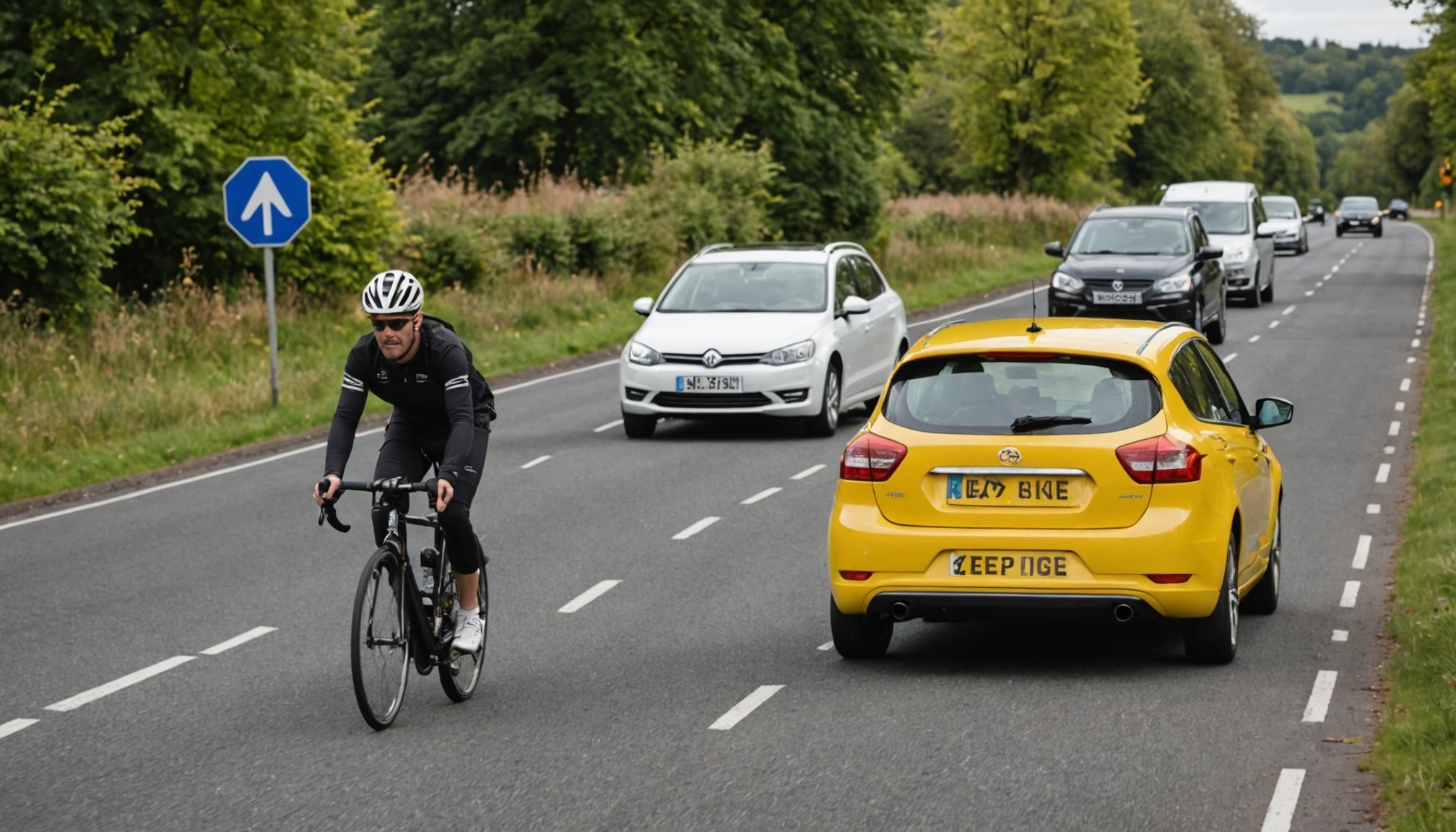Importance of Road Safety for Cyclists and Drivers
Understanding the road safety importance in the UK is vital for both cyclists and drivers. Current UK road statistics highlight the significant number of accidents involving cyclists, revealing a notable risk on the roads. Accidents can result in serious consequences, including injuries or fatalities, affecting both cyclists and drivers. These statistics underscore the necessity of heightened awareness and proactive measures to improve safety.
Cyclists and drivers must share the road with mutual respect and vigilance. The importance of being aware of each other’s presence cannot be overstated. Drivers should be attentive to the vulnerabilities of cyclists, while cyclists must ensure they are visible and predictable in their movements.
In parallel : Unveiling cutting-edge advancements in the uk”s smart motorway system and their effects on drivers
Mutual respect begins with simple practices like maintaining safe distances and anticipating the actions of others. By fostering an environment of care and respect, the number of accidents can potentially decrease. This collaboration is crucial in creating safer roads for everyone.
Finally, awareness efforts encourage all road users to engage in safety practices. Educational campaigns, community workshops, and safety pledges are excellent starting points to promote road safety culture, urging both cyclists and drivers to be accountable and responsible.
In the same genre : 2024 uk automotive landscape: must-watch trends and groundbreaking innovations
Essential Gear for Cyclists
The use of cycling safety gear is paramount for ensuring the wellbeing of cyclists on the road. Among the essential items, high-visibility clothing plays a critical role, especially in low-light conditions. Bright colours and reflective materials make cyclists more noticeable to drivers, thereby reducing the risk of accidents.
Protective equipment like helmets, knee pads, and elbow pads are non-negotiable. These items can greatly mitigate injuries in the event of a fall or collision. Helmets, in particular, are vital as they protect the most vulnerable part of the body—the head. It’s crucial for cyclists to always ensure that these protective elements are not just worn, but also correctly fitted for maximum effectiveness.
Additionally, a well-maintained bicycle significantly enhances safety. Regular checks of brakes, tires, and lights are necessary. Proper bicycle maintenance ensures that the vehicle is roadworthy and responsive, decreasing the likelihood of mechanical failures that could lead to accidents. A smoothly functioning bike not only contributes to a safer ride but also sets a foundation for enjoyable cycling experiences. Familiarisation with maintenance routines and timely interventions can make all the difference.
Defensive Driving Techniques
Given the ever-evolving traffic conditions, employing effective defensive driving techniques is essential for maintaining road safety. A crucial strategy is anticipation—drivers should consciously scan the road ahead, watching out for potential hazards such as sudden stops or lane changes. This proactive approach helps in avoiding unexpected collisions and safeguarding both drivers and cyclists.
Defensive driving tips also emphasize maintaining a safe following distance. The rule of thumb is to keep at least a two-second gap between vehicles to allow sufficient reaction time. Particularly in poor weather conditions or during night travel, extending this distance can be lifesaving. Engage in safe manoeuvring by signalling intentions clearly and adhering to speed limits.
Increasing driver awareness about the presence of cyclists is fundamental. Recognising blind spots and understanding the dynamics of shared road use ensure better harmony. By respecting cyclists’ right to share the road, and being vigilant about their proximity, drivers contribute to a safer travel environment.
Embracing these safe driving practices not only protects individual drivers but also cultivates a culture of responsibility and mutual respect on the roads.
Visibility and Awareness
Enhancing road visibility is crucial for both cyclists and drivers to ensure safety, particularly during night travel. For cyclist visibility tips, using effective lighting on bicycles is paramount. Bikes should be equipped with front white lights and rear red lights, which are not only a legal requirement in many places but also pivotal in preventing accidents. Additionally, night cycling safety can be improved by adding reflective materials to clothing and bike components. These enhancements significantly increase a cyclist’s visibility to drivers and help avert potential collisions.
Drivers, too, must maintain high levels of awareness, especially in adapting to reduced visibility conditions. Recognising blind spots is a key part of this awareness. Many accidents occur when cyclists are not seen in these areas when vehicles manoeuvre. Drivers are encouraged to double-check their mirrors and physically turn to check for cyclists before changing lanes or making turns. Understanding common hazards such as poor lighting, obstructive weather conditions, or busy junctions is essential for both cyclists and drivers to safely share the road. Remaining vigilant and prioritising visibility can dramatically reduce the risk of accidents, fostering safer interactions on the road.
Common Hazards on the Road
When discussing road hazards, recognising their diverse nature is essential for both cyclists and drivers. Traffic conditions can change rapidly, presenting common hazards such as potholes, debris, and unpredictable pedestrian crossings. Awareness and identification of these issues are crucial to staying safe.
The ability to navigate such challenges with safe manoeuvring is vital. Cyclists should maintain control by reducing speed and avoiding sudden direction changes when encountering obstacles. Conversely, drivers should adjust their speed and be prepared to brake or change lanes swiftly to avoid potential threats.
Understanding local traffic laws and regulations aids in safely negotiating challenging road conditions. Knowing the rules regarding right of way, pedestrian crossings, and road sharing etiquette helps in ensuring safer travel.
Compliance with these laws facilitates smoother road sharing among users. By being aware of the traffic conditions and potential road hazards, all individuals can employ effective strategies to contribute to a safer road environment. By remaining informed and vigilant, cyclists and drivers can better anticipate and respond to these hazards, thus reducing the risk of accidents.
Sharing the Road Responsibly
Sharing the road requires understanding and cooperation from both cyclists and drivers. One important aspect is adhering to road sharing etiquette. This includes maintaining a safe distance when passing cyclists and ensuring that cyclists have enough room to manoeuvre without feeling threatened.
Communication on the road is vital. Cyclists can use hand signals to indicate turns or stops, while drivers should use eye contact to acknowledge that they have seen the cyclist’s intentions. This mutual understanding can prevent misunderstandings and accidents.
Cultivating respect amongst road users is crucial for safety. Drivers should be patient, understanding that cyclists are more vulnerable, while cyclists should adhere to traffic rules to not impede the flow of traffic unnecessarily. Recognising each individual as a participant in road safety promotion can foster a safer environment.
Safe passing techniques are essential. Drivers should always pass cyclists with a significant gap, adhering to local laws which usually mandate at least a 1.5-meter distance. This ensures that cyclists feel secure, particularly at high speeds or on narrow roads.
By respecting these simple guidelines, road users can create a safer, more harmonious environment for everyone.
Legal Responsibilities and Rights
Understanding the road safety laws in the UK is crucial for both cyclists and drivers. Cyclists have specific legal obligations, such as obeying traffic signals, using lights, and not riding on pavements, which ensure their safety and that of others. Ignoring these obligations can result in fines and penalties.
Cyclists’ rights are protected under UK law, allowing them to ride on roads where bicycles are permitted and to use designated bike lanes. These rights are enforceable, providing cyclists with legal protection in case of disputes. For instance, cyclists have the right to report harmful driving behaviours that compromise their safety.
Drivers, on the other hand, have the responsibility to respect these rights and to adhere to speed limits and other traffic regulations. Failure to comply not only endangers cyclists but also results in legal consequences for drivers. For example, not allowing enough space when overtaking a cyclist can lead to penalties.
To promote better understanding and compliance, the government has various road safety resources and official guidelines. Cyclists and drivers are encouraged to stay updated on these regulations, as traffic laws can evolve with changing road conditions and technology.
Resources and Further Reading
Understanding and staying updated on road safety regulations is crucial for cyclists and drivers alike. Numerous road safety resources offer valuable information to help road users adhere to necessary guidelines. Organisations such as the Department for Transport provide comprehensive official guidelines for safe road practices.
For cyclists, engaging with resources related to local traffic laws is beneficial to ensure compliance with rules, such as required safety gear and road rights. Websites like Cycling UK give insights into both the obligations and rights cyclists have on roads, promoting safer cycling experiences. Additionally, Bikeability offers training schemes aimed at improving cycling proficiency and road awareness.
Drivers can benefit from road user manuals available online that outline safe driving practices and defensive driving tips. These resources help in fostering a safer driving culture and understanding cyclists’ needs for greater road-sharing etiquette.
Staying current with road safety updates is vital since regulations can change with emerging technologies and evolving traffic conditions. Regular review of official guidelines ensures all road users contribute positively to road safety. Accessing these resources regularly enhances awareness, assists with compliance, and ultimately makes roads safer for everyone.








